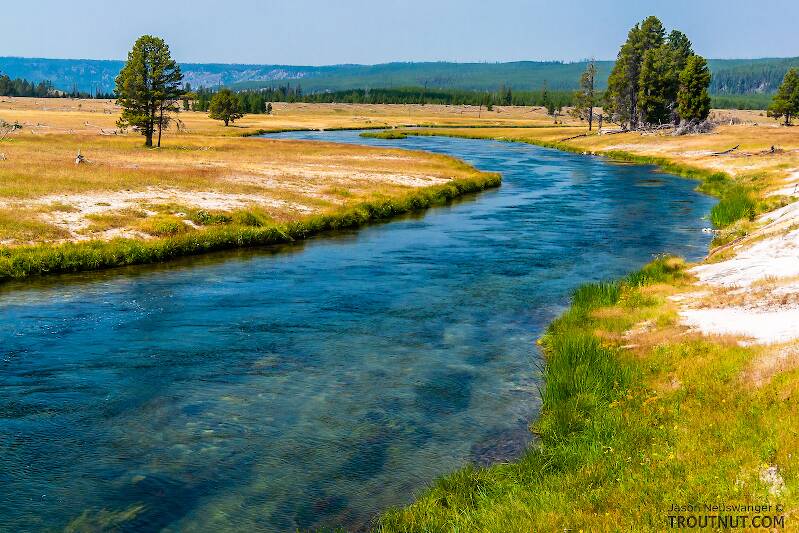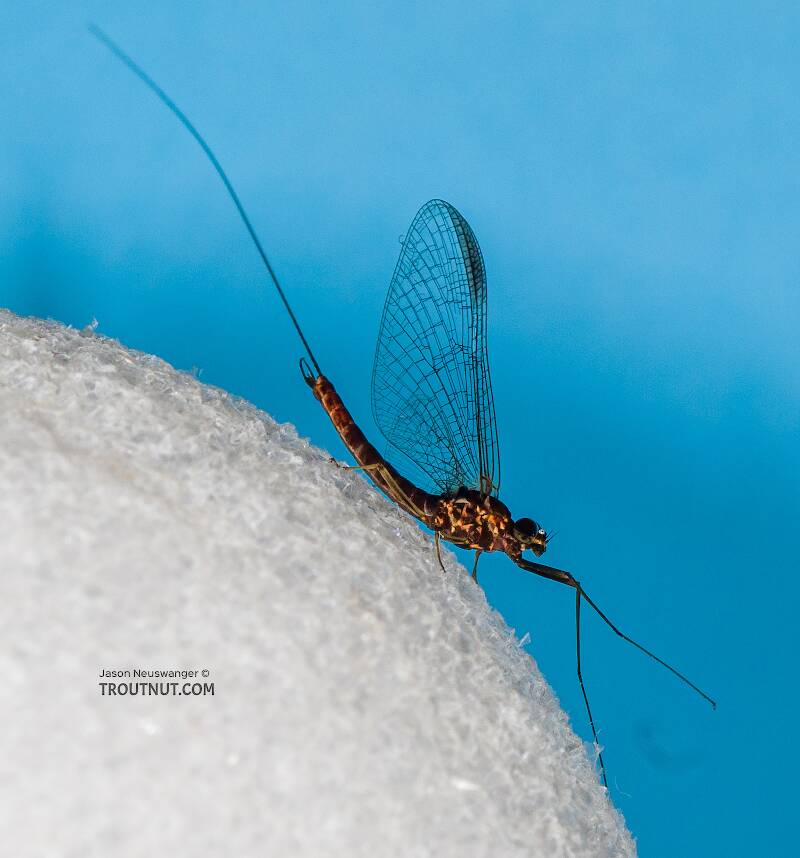
Salmonflies
Pteronarcys californica
The giant Salmonflies of the Western mountains are legendary for their proclivity to elicit consistent dry-fly action and ferocious strikes.
Featured on the forum


Troutnut is a project started in 2003 by salmonid ecologist Jason "Troutnut" Neuswanger to help anglers and
fly tyers unabashedly embrace the entomological side of the sport. Learn more about Troutnut or
support the project for an enhanced experience here.
Western March Browns
Like most common names,"Western March Brown" can refer to more than one taxon. They're previewed below, along with 5 specimens. For more detail click through to the scientific names.
Mayfly Species Rhithrogena morrisoni
These are pretty much always called Western March Browns.
Despite the reputation of Rhithrogena as being the most tenacious of clingers, Rhithrogena morrisoni or Western March Brown has the greatest populations in moderate runs over cobble. It can reach amazing densities in this water type on rivers like the Rogue in Oregon, Lower Yuba In California, and the Henry's Fork in Idaho.
These large flies range between 9mm and 12mm and are the first important hatch of the year. Generally speaking, they have two distinct color phases and hatching periods, with the Coastal states having the lighter version emerging late February through April in lower elevation tailwaters and the darker version in the Rocky mountain states emerging a month or two later. This has led to much confusion as these significant regional differences are seldom pointed out in angling literature.
They offer the western angler some of the finest fishing of the year during moderate precipitation cycles. It's biggest spoiler is high water or early runoff. On many rivers, there is also a fine hatch of a large late Winter stonefly (Skwala spc.) that usually precedes it that helps to get the fish "looking up". It is the West's equivalent of the East's mottle winged Macaffertium vicarium (American March Brown), both in terms of appearance and importance. Primarily due to western fishing seasons of the past that excluded this mayfly's activity, reporting on this species in angling literature is a relatively recent phenomenon. Thus, it lags in tradition compared to the blotchy winged Heptageniidae of the East and Midwest. But given time...
These large flies range between 9mm and 12mm and are the first important hatch of the year. Generally speaking, they have two distinct color phases and hatching periods, with the Coastal states having the lighter version emerging late February through April in lower elevation tailwaters and the darker version in the Rocky mountain states emerging a month or two later. This has led to much confusion as these significant regional differences are seldom pointed out in angling literature.
They offer the western angler some of the finest fishing of the year during moderate precipitation cycles. It's biggest spoiler is high water or early runoff. On many rivers, there is also a fine hatch of a large late Winter stonefly (Skwala spc.) that usually precedes it that helps to get the fish "looking up". It is the West's equivalent of the East's mottle winged Macaffertium vicarium (American March Brown), both in terms of appearance and importance. Primarily due to western fishing seasons of the past that excluded this mayfly's activity, reporting on this species in angling literature is a relatively recent phenomenon. Thus, it lags in tradition compared to the blotchy winged Heptageniidae of the East and Midwest. But given time...
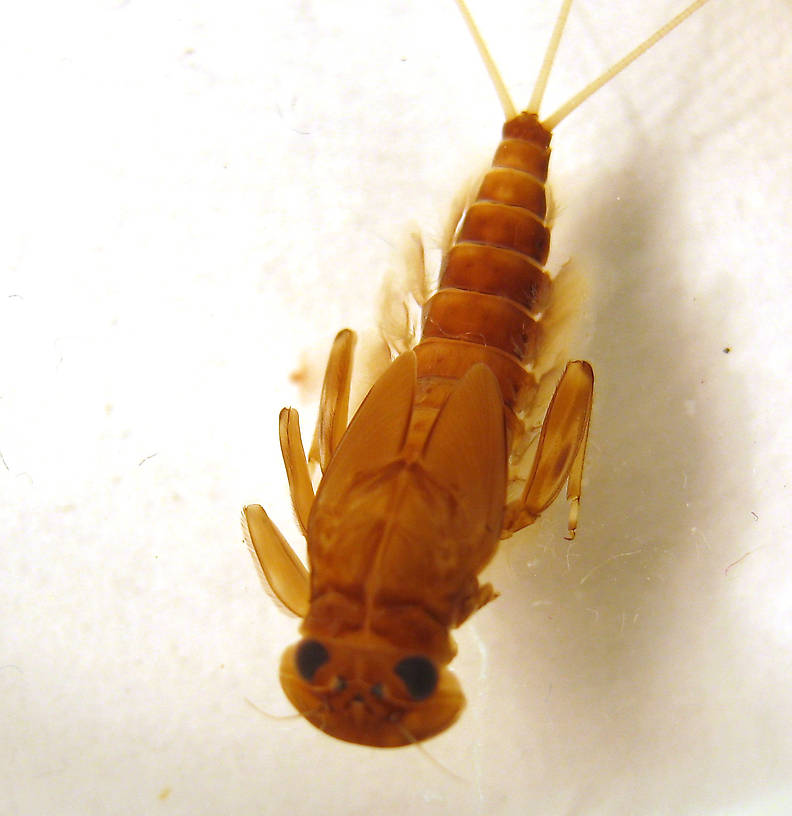
Size - (excluding tails) - 12 mm
Status at time of photo - preserved, but photographed within days of capture.
W. C. Day, Aquatic Insects of California differentiates morrisoni nymphs by submedian pale dots on tergites 8 & 9, which look to be in evidence. This is one of the "super-hatches" on this river that can be prolific March through April.
Entoman
Status at time of photo - preserved, but photographed within days of capture.
W. C. Day, Aquatic Insects of California differentiates morrisoni nymphs by submedian pale dots on tergites 8 & 9, which look to be in evidence. This is one of the "super-hatches" on this river that can be prolific March through April.
Entoman
See 2 more specimens...
Mayfly Species Rhithrogena hageni
These are often called Western March Browns.
According to Fred Arbona in Mayflies, the Angler, and the Trout, this is an excellent hatch and one of the most common fast-water mayflies in the West.
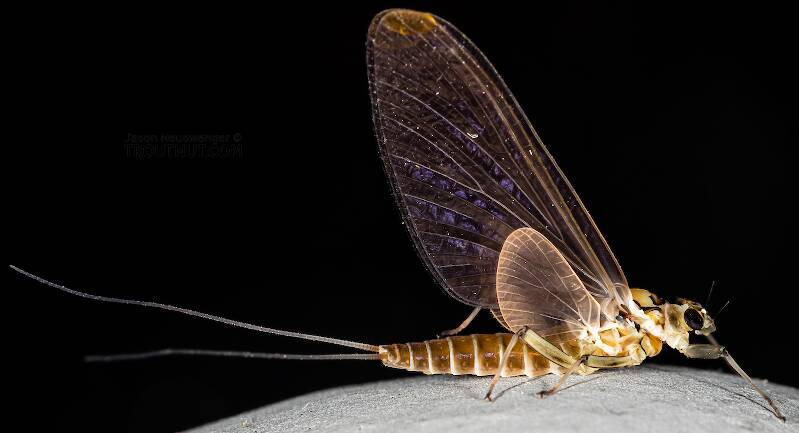
I was surprised by the olive cast on the body of this female Rhithrogena dun, which led me to mistake it for a western green drake (Drunella) in the field. I was pleasantly surprised to get a closer look and find something I hadn't collected yet. Its species ID is based on proximity to male spinner collected on the same trip, as well as physical similarity (size, tergite coloration, dark streaks on the femora) to that specimen.
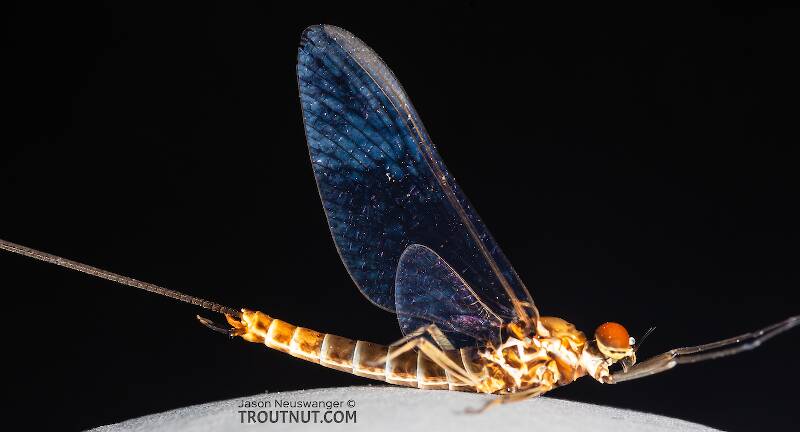
Although I could not find the preserved specimen to examine under my good new microscope, I'm tentatively calling it one Rhithrogena hageni, based on apparent similarity to this specimen, which I was able to positively ID.
The relative angle of the penes is a bit shallower in this specimen, but I photographed another specimen from the same collecting trip (and I think even the same swarm, although I don't recall for sure) as the other one, and it had the shallower angle seen on this specimen. I'm guessing it's just variation within the species.
The relative angle of the penes is a bit shallower in this specimen, but I photographed another specimen from the same collecting trip (and I think even the same swarm, although I don't recall for sure) as the other one, and it had the shallower angle seen on this specimen. I'm guessing it's just variation within the species.
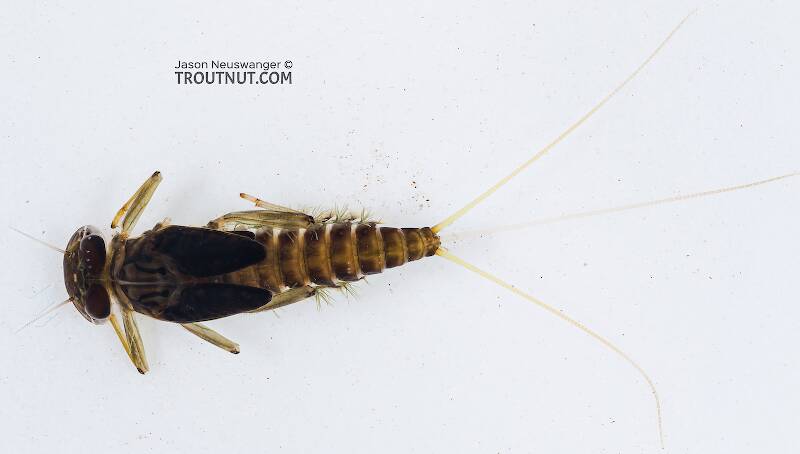
This mature nymph was collected in the same riffle as a male spinner, from which I got the identification for both.
See 3 more specimens...
References
- Arbona, Fred Jr. 1989. Mayflies, the Angler, and the Trout. Nick Lyons Books.

